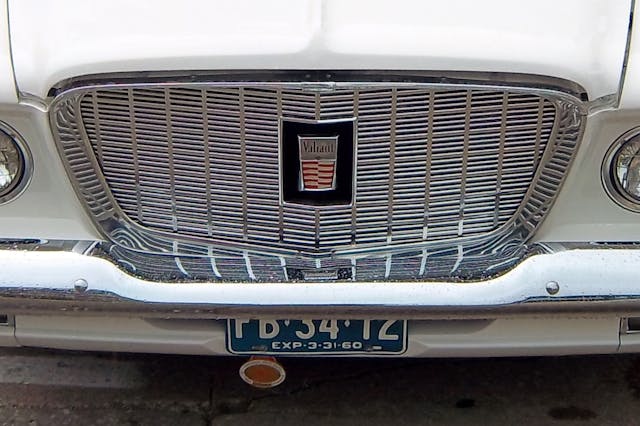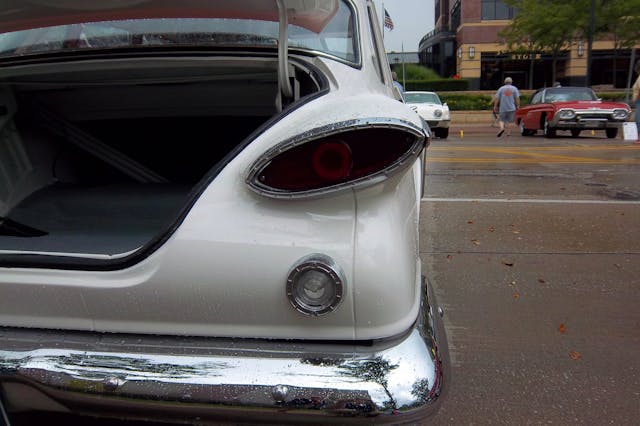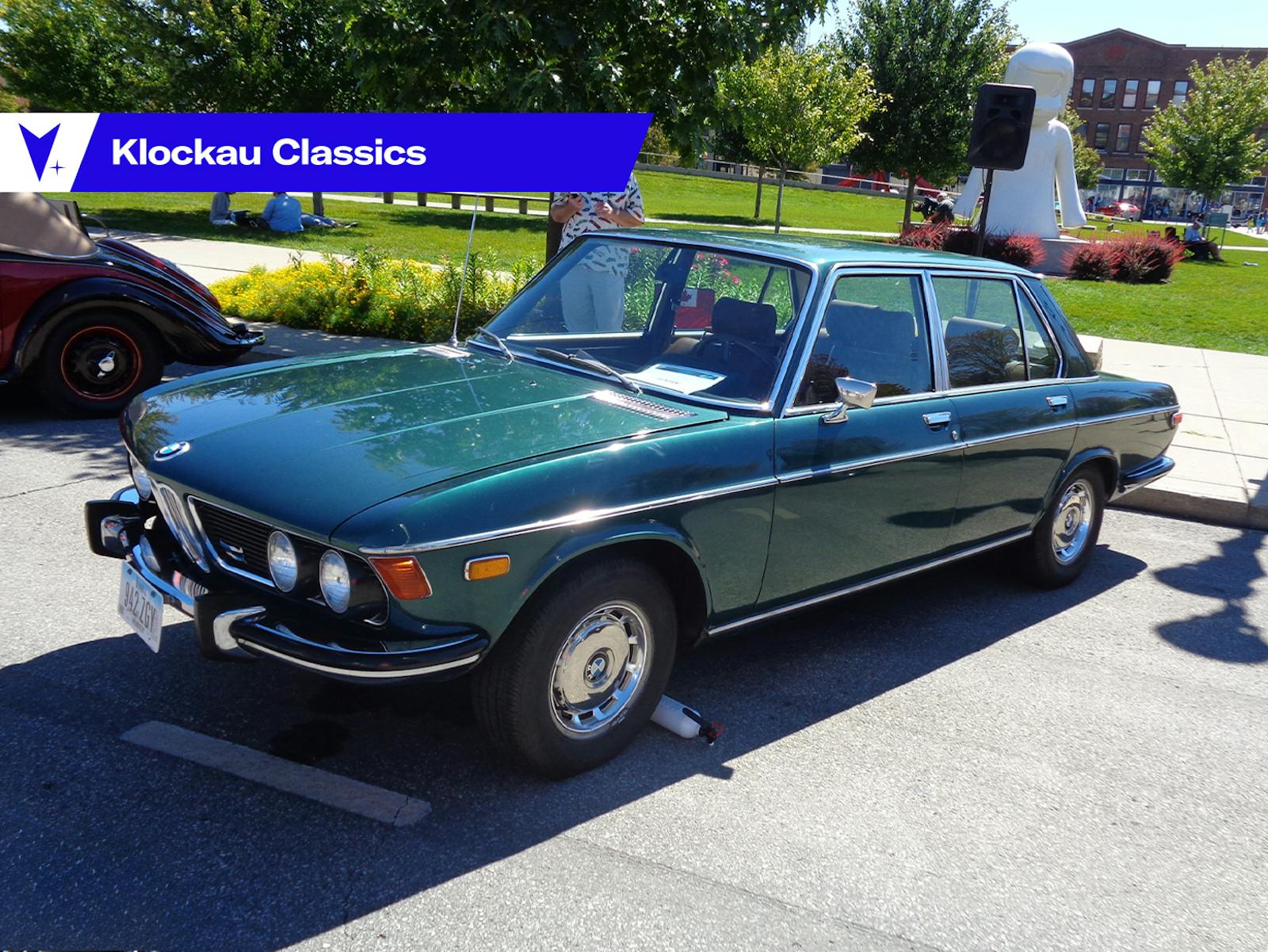1960 Valiant V-200: Please don’t call it a Plymouth!

Valiant. Mention the name to anyone who was a kid in the ’60s and you’ll almost certainly prompt some diverse memories. “Oh, my Aunt Freda and Uncle Sid had one, it was the toughest car they ever had!” Or, “I drove one in high school, got it for $100 off a shady used car lot and it was the dullest, slowest car I ever owned!” Or, in the case of my mother, “Oh, I remember those. Chicken Delight in Davenport used them as delivery vehicles. They all had a cartoon chicken on the roof!”
(By the way, does anyone remember Chicken Delight?)
Anyway, in approximately 99.895 percent of these circumstances, these nostalgic speakers will refer to the Plymouth Valiant. Of course, Valiants were Plymouths from 1961 through 1976—but not in the nameplate’s inaugural year of 1960. Yes, 1960, a Buck Rogers year for sure! It was also The Year of the Compacts: Corvair, Falcon, and of course, the Valiant.

Chrysler Corporation’s response to the mini-import boom of the late 1950s—an influx chiefly led by Volkswagens, but also by Fiats, Renaults and various English Fords and GM-made Vauxhalls—was much more stylish distinctive than the shrunken-full-size-Galaxie Ford Falcon and the far-out, rear-engined Chevrolet Corvair. Virgil Exner was clearly the father of the Valiant; its wild sheetmetal bore witness to its ancestry. From every angle, the Valiant was its own car—definitely not a mini-me Fury, Belvedere, or Polara.

The 1960 Valiant was every bit a Chrysler product, with unibody construction, torsion-bar front suspension, and an optional push-button automatic transmission. A floor-mounted three-speed stick was standard equipment. Valiants came in two flavors: the plain V-100 and the somewhat-fancier V-200.

The V-100 was the base model, with minimal chrome trim and the sole interior choice of gray cloth seats. Regardless of model, though, all Valiants had the brand-new “Slant Six” engine. Displacing 170.9 cubic inches, it produced 101 hp at 4400 rpm. The optional “Hyper Pack” engine produced 148 hp.

At first, only four-door sedans were available. Later in the model year Chrysler added a station wagon, but no two-doors were available until 1961. Even then, the coupe was clearly derived from the four-door, and even wore the same roof panel.

Optional extras for Valiants included a push-button radio, a padded dash, a power rear tailgate window for wagons, and the usual power brakes, power steering, and whitewall tires. Air conditioning was a princely $446 (the two trim levels, as we’ll see below, differed by only $77!). An automatic transmission rang in at $172.

The up-level V-200 offered much nicer upholstery in three color choices. Seats boasted vinyl bolsters and nylon inserts, and the doors sported two-tone interior panels. Outside, V-200s were set apart by bright side moldings that wrapped around the flared rear wheel arches, as well as bright window trim.
A V-100 sedan started at $2033, and the V-200 at $2110.

As mentioned earlier, soon after the sedans made their debut, V-100 and V-200 station wagons were added to the lineup. These little haulers were perhaps even more wild-looking than the sedans. Wagons were available in six-passenger V-100 and V-200 configuration and as a nine-passenger V-200 model.

At $2546, the nine-seat wagon was the most expensive ’60 Valiant, and it was also the rarest: just 4675 were built. Try and find any 1960–62 Valiant wagon now. I’ve never seen one, and I go to a lot of car shows.

I spied this pristine 1960 V-200, one of 106,515 built, at the AACA Grand National meet held in Moline, IL in June 2013. Living ten minutes away from the event guaranteed my attendance. Despite rain that never entirely went away that afternoon, I saw plenty of great classic cars. The styling is certainly polarizing, but I love them!

That almost Italian-style race-car grille is a big plus to me. It was not until recently that I realized the Valiant badge on the grille did double duty as a hood release. Functional and attractive.

The Valiant stood alone in 1960–but for that year only. In 1961, it officially became a Plymouth. Plymouth needed the extra sales, since Dodge’s full-size, Plymouth-based 1960 Dart had led many Plymouth loyalists to cross the street to the Dodge dealer. While 1960 and 1961 were not good years for full-size Plymouth sales, the Valiant was a bright spot, and would continue to be for years to come.



Had a 60 before it became a Plymouth. Mine had the standard slant six with the 3 on the floor shifter. Loved that car.
I had a 1960 Valiant, white, red interior, with 4 1959 Dodge Lancer spinner hubcaps. Sharp care and I loved it in high school!
I had the same. Mint green. My first car, bought itin 1967.
Ditto, 170 plain jane, may have been a Coca Cola bottler car.
When sold, it got shipped down under as their bodies are different and ours are a novelty.
My. Teacher. In. High school. Had. A. 1960
Valiant. Black. Red. Upostery. Big. Six.
Three. Speed. Manual. . said. It. Was. Plenty
Fast. For. Him. I loved. The. Styling
Not. Run. Of. Mill. Check. The. Zero. To
Sixty. Time. With. Big. Six. .
Don’t cook tonight, call Chicken Delight!
I was just 5 years old in 1960, but I was already on my way to being a lifetime Gearhead, at 68, I can say that’s exactly what I have been my entire life. Born in Detroit my parents moved to Southern California in 1958. Prior to that my mom’s side of the family all worked at Chrysler’s Highland Park headquarters location and my dad’s side worked at Ford Motor Company in Dearborn. The entire family drove Chrysler products with a few Fords thrown in. We drove to California in a new 58 Dodge Custom Sierra wagon. It was red and white with white and black cloth interior. In 1960 my dad wanted a smaller car than that big Dodge wagon. His visit to the local Chrysler Plymouth dealer in the San Fernando Valley in early 1960 is where he first found the Valients being unloaded from the truck. He spotted a white with red and black cloth interior and a 3 speed manual transmission on the floor. I think it was a V200, because it had a lot of chrome on it. He bought it as soon as he could, in fact he was the first one to buy a Valient in the San Fernando Valley, but that didn’t last long. My aunt, my grandfather and my mom’s cousin all bought one, and they were all white with black and red interior. They were all V200s and had the push button drive automatic transmission. After that a few neighbors had bought them, one was red, another was light blue and another white one. In 1962 my grandfather traded his first one in and bought a blue one. There was also a 1963 two door hardtop in a dark brown color, it was in the new Signet top of the line trim. Also in 63 my dad bought a 63 Chrysler Newport, 4 door hardtop, white with blue vinyl interior. It was also the first car in the family to have factory installed air conditioning. In early 1964 my parents bought a 64 Valient V200 station wagon, it was white with red interior the seats were red vinyl tuck and roll. Between 63 and 64, Valients received a major styling update, they became more boxy and now had single headlights a new grill and narrow vertical taillights. In 68, my grandfather updated again to another Valient. It was a 4 door sedan in the very popular at the time olive green metallic and a tan interior. That turned out to be the last Valient bought in the family, and it stayed in the family until the late 70s. The 63 Newport was traded for a 69 Chrysler 300, a white with dark blue vinyl top with matching vinyl interior, 4 door hardtop. It also had Chrysler’s famous 440 cid V8 with a 4 barrel Carter carburetor. Man, that car was fast, it was so powerful it would churp the rear tires as it shifted from first to second gear. The only automatic transmission I ever saw do that. In the 70s, my uncle bought a 72 Chrysler New Yorker, dark brown metallic paint no vinyl top, and light tan interior. It too had a 440 under the hood but it was detuned to meet emissions requirements, we also had 2 Cordobas in the family, they both had plenty of problems with Chrysler’s Lean Burn ignition system. They would be the last Chryslers to be in our family. After years of nothing but Chrysler products, we switched to Fords. A 1975 Mercury Marquis Colony Park wagon, white with tan interior with a huge 460 4 barrel Motorcraft 4300 series carburetor, a 73 F-150 with a 390 in it and a 76 Lincoln Town Car for my mom to drive, it was beautiful and it also had a 460 4 barrel Motorcraft 4300 carburetor. It’s been Fords, Mercurys and Lincolns, Explorers and more F-series trucks. I’m on my second Explorer, a 2008, a 4.6 V6 injected engine, XLR, black with gray cloth interior and even though it’s the first non V8 I’ve ever owned, I love it. There’s only a small difference in power from the 5.0 V8 I had in my 97 black Eddie Bauer Explorer. It was the mid 70s when Chrysler’s financial issues became a problem and that began to show up in their cars. That was sad because Chrysler’s were always known for their progressive engineering and reliability in it’s past, but that was no longer the case. I still have a fondness for Chrysler and with it escaping death a few times, I’m glad to say they are still with us albeit owned by Stellantis..